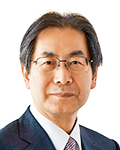Messages from Keidanren Executives and Contributed articles to Keidanren Journals February, 2022 Policy & Action

When I joined Keidanren in April 1976, the Secretariat was called a dantaiya (talking shop), and at the time, the more senior employees were engaging in heated discussions with bureaucrats as policy professionals in various fields. They all had strong personalities, and there was no particular training for new employees. Rather, we were expected to learn by watching their example. Keidanren suddenly came to prominence thanks to the Second Provisional Commission on Administrative Reform, which was chaired by former Keidanren chairman Toshio Doko, in the 1980s. Around the same time, Keidanren started regular recruitment of outstanding university and graduate school graduates. In recent times, the Keidanren Secretariat has earned praise as the business community's think tank, and I am delighted by this appraisal.
About 10 years ago when Keidanren moved to new premises, then-president Ryuko Wada instructed me, as head of the General Administration Bureau, to take the relocation as an opportunity to prepare a mission statement and action plan for the Secretariat. The outcome, which I compiled with several of my coworkers, is set out below. Since then, at every opportunity I have urged Secretariat staff to rigorously abide by these principles.
1. Mission Statement
We formulate policies based on fair opinions from the business community, strive to realize such policies (Policy & Action), and contribute to autonomous economic development and improvement of people's lives in Japan.
2. Action Plan
- (1) Aim to be a policy group that takes action, while maintaining close communication with members and responding to their needs.
- (2) Anticipate changing times, and in the aim of creating a vibrant economy and society led by the private sector, propose policies and strive to realize them.
- (3) Seek understanding and cooperation through interaction and dialogue with the business community and a wide range of people and organizations.
- (4) Aim to be an open and constantly-evolving organization that enables people to develop and make the most of their skills.
- (5) Ensure rigorous compliance and appropriate accountability, and strive to earn trust within and outside the organization.

